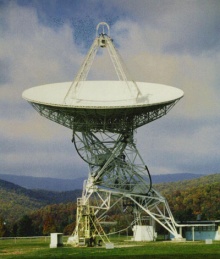|
|
| (未显示2个用户的14个中间版本) |
| 第1行: |
第1行: |
| − | <资料来源:[http://www.planetary.org/explore/topics/seti/seti_history_09.html The Planetary Society]> | + | <资料来源:[https://archive.md/2008.11.15-120433/http://www.planetary.org/explore/topics/seti/seti_history_09.html Ozpa - A Skeptic's Search]> |
| | | | |
| | | | |
| − | =='''第9章:Opza - 一个怀疑论者的搜索'''== | + | =='''第9章:Ozpa - 一个怀疑论者的搜索'''== |
| | | | |
| − | The lingering questions about how to conduct a search were still very much in evidence in the first post-Ozma SETI project in the United States. So much so that the search leader himself, G. L. Verschuur of the NRAO, expressed serious doubts about the purpose of the enterprise: "It is the author's belief," he wrote in an article describing the project, "that any detection of signal from another civilization will most likely be an accidental one in the sense that we will pick up signals not meant for us. For this reason it is unlikely . . . that a wavelength around 21 cm is the wavelength at which to search." These are indeed serious misgivings, coming from the very person who was to conduct the search.
| + | 然而,对搜索项目应该如何开展仍然存留了一些疑问,这在 Ozma 之后美国的第一个 [[SETI]] 项目上面就非常明显。以至于项目的发起人他自己,NRAO 的 G. L. Verchuur,都对这项事业的目的表露出了自己的怀疑。他在一篇描述这个项目的文章中说到:“我(作者)认为,如果我们能探测到任何其它文明的信号,很有可能只是碰巧而已,也就是说那个信号并不是特意发给我们的。因为这个原因,只去探测 21 厘米附近的波长可能并不太合适。”来自项目发起人的这番话,其中确实包含了深深的困惑。 |
| | | | |
| | | | |
| − | [[Image:ozma_telescope.jpg|right|thumb|220px|'''The Project Ozma Radio Telescope'''<br> | + | [[Image:ozma_telescope.jpg|right|thumb|220px|'''Ozma 项目使用的射电望远镜'''<br> |
| − | The 85 foot radio telescope at Green Bank used by Project Ozma as it appears today. Credit: NRAO/AUI]]
| + | 位于 Gree Bank 的 85 英尺直径射电望远镜,曾被 Ozma 项目所使用,照片是新近拍摄的。图片提供:NRAO/AUI]] |
| | | | |
| − | Nevertheless, Verschuur went ahead with his program. Conceived as a direct continuation of Drake's 1960 project, it was based, like Ozma, in Green Bank, West Virginia. Whereas Drake had to content himself with the use of an 85-foot radio telescope, Verschuur had the use of a 300-foot dish and a 140-foot dish, as well as far more advanced sensitive equipment. Over the course of 1971 and 1972 Verschuur pointed his instruments at nine nearby stars, including the ones targeted by Ozma, listening at the hydrogen line frequency and correcting for Doppler shifts. In some respects it was an expanded and improved "Ozma," but in other respects it was a much smaller project: whereas Drake's team devoted 150 hours to their observations over three months, Verschuur and his colleagues spent only 13 hours observing over the span of two years. Nevertheless the similarities were such that Verschuur's search became popularly known as "Ozpa."
| + | 不管怎样,Verschuur 还是继续了他的项目。作为 1960 年 Drake 项目的直接延续,新项目也位于西弗吉尼亚的 Green Bank。Drake 只能使用一个 85 英尺直径的射电望远镜,而 Verschuur 可使用的天线直径分别是 300 英尺和 140 英尺。在 1971 年和 1972 年间,Verschuur 将他的设备对准了九个临近的恒星,其中也包括了 Ozma 项目所研究过的一些恒星,新项目也是在氢线频率进行监听,并进行了多普勒效应修正。从某些方面来看,新项目可以看作是 Ozma 项目的扩展改进版,但从另一些方面来看,新项目的规模小得多:Drake 的团队在三个月的时间内进行了 150 小时的观测,而 Verschuur 和他的同事总共只进行了 13 个小时的观测,而且是在两年的时间内。但不管怎样,两个项目还是很相似的,以至于 Verschuur 的项目经常会被人们称之为“Ozpa”。 |
| | | | |
| | | | |
| − | Ozpa was followed by a larger and more sustained NRAO search designated "Ozma II," which surveyed 674 stars over 500 hours between 1972 and 1976. Over the next three decades, many searches followed. Most of them were small and limited in scope, depending on available telescope time at established observatories, and designed to test a researcher's particular hypothesis. Some, however, were larger and more sustained and a few of those will be mentioned here. | + | 在 Ozpa 之后还有一个更大更持久的 NRAO 搜索项目,称之为“Ozma II”,该项目在 1972 年和 1976 年之间,花费了超过 500 个小时对 674 颗恒星进行了调查。再之后的三十多年,还有一些后续搜索项目,但大部分项目的规模都比较小,往往都是利用观测站空闲的望远镜时间,用来验证一些研究人员的特定想法。然而,还是有一些规模比较大、持续时间比较长的项目,其中一些我们接下来将会说到。 |
| | | | |
| | | | |
| − | [[SETI的历史:8:The New Searches,新的搜索|'''第8章:The New Searches,新的搜索 ←''']] | [[SETI的历史:10:"Wow!",“哇!”|'''→ 第10章:“哇!”''']] | + | [[SETI 的历史|'''返回 SETI 的历史 ←''']] | [[SETI 的历史 - 8|'''第8章:新的搜索 ←''']] | [[SETI 的历史 - 10|'''→ 第10章:“哇!”''']] |
| − | | |
| − | | |
| − | ==相关链接==
| |
| − | *[[SETI]]
| |
| − | *[[SETI@home]]
| |
| − | *[[SETI的历史]]
| |
| − | | |
| − | [[Category:SETI@home相关文献]][[Category:文献翻译]]
| |
<资料来源:Ozpa - A Skeptic's Search>
第9章:Ozpa - 一个怀疑论者的搜索
然而,对搜索项目应该如何开展仍然存留了一些疑问,这在 Ozma 之后美国的第一个 SETI 项目上面就非常明显。以至于项目的发起人他自己,NRAO 的 G. L. Verchuur,都对这项事业的目的表露出了自己的怀疑。他在一篇描述这个项目的文章中说到:“我(作者)认为,如果我们能探测到任何其它文明的信号,很有可能只是碰巧而已,也就是说那个信号并不是特意发给我们的。因为这个原因,只去探测 21 厘米附近的波长可能并不太合适。”来自项目发起人的这番话,其中确实包含了深深的困惑。

Ozma 项目使用的射电望远镜 位于 Gree Bank 的 85 英尺直径射电望远镜,曾被 Ozma 项目所使用,照片是新近拍摄的。图片提供:NRAO/AUI
不管怎样,Verschuur 还是继续了他的项目。作为 1960 年 Drake 项目的直接延续,新项目也位于西弗吉尼亚的 Green Bank。Drake 只能使用一个 85 英尺直径的射电望远镜,而 Verschuur 可使用的天线直径分别是 300 英尺和 140 英尺。在 1971 年和 1972 年间,Verschuur 将他的设备对准了九个临近的恒星,其中也包括了 Ozma 项目所研究过的一些恒星,新项目也是在氢线频率进行监听,并进行了多普勒效应修正。从某些方面来看,新项目可以看作是 Ozma 项目的扩展改进版,但从另一些方面来看,新项目的规模小得多:Drake 的团队在三个月的时间内进行了 150 小时的观测,而 Verschuur 和他的同事总共只进行了 13 个小时的观测,而且是在两年的时间内。但不管怎样,两个项目还是很相似的,以至于 Verschuur 的项目经常会被人们称之为“Ozpa”。
在 Ozpa 之后还有一个更大更持久的 NRAO 搜索项目,称之为“Ozma II”,该项目在 1972 年和 1976 年之间,花费了超过 500 个小时对 674 颗恒星进行了调查。再之后的三十多年,还有一些后续搜索项目,但大部分项目的规模都比较小,往往都是利用观测站空闲的望远镜时间,用来验证一些研究人员的特定想法。然而,还是有一些规模比较大、持续时间比较长的项目,其中一些我们接下来将会说到。
返回 SETI 的历史 ← | 第8章:新的搜索 ← | → 第10章:“哇!”
